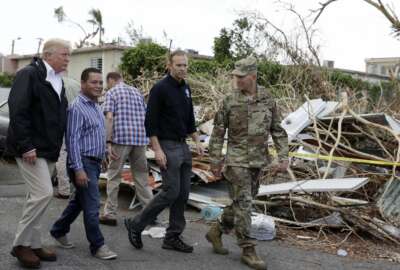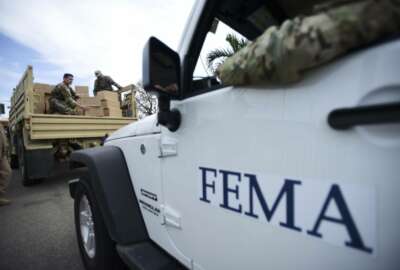
FEMA’s Brock Long: Neither Noah nor Moses
In the aftermath of last year's hurricane triple-whammy, state government needs to realize they're the first responders, not FEMA.
Best listening experience is on Chrome, Firefox or Safari. Subscribe to Federal Drive’s daily audio interviews on Apple Podcasts or PodcastOne.
Ever since Noah, flood response has been problematic. Only eight people survived that one. Now the Federal Emergency Management Agency is in the spotlight for a hurricane season that’s starting out with the potential for biblical-style flooding. Two questions dominate the day. Was FEMA any good during last year’s triple whammy? And will it be good this weekend?
You might say it’s showtime for Administrator Brock Long.
Few phenomena test the government’s credibility more than emergency response. That goes for government at all levels. But FEMA somehow seems to attract the hopes and fears of everyone touched by a disaster — more like Moses than Noah.
Between President Donald Trump’ assertion of “incredible success” and his opponents’ claims of total failure lies the reality. FEMA neither did nothing, nor built the world’s biggest ark to float everyone safely. It did send thousands of people, abetted by thousands more in the so-called surge force. It did enlist the Army Corps of Engineers for generator and blue-tarp duty. It did have some supplies pre-positioned, a lesson learned dating to Katrina.
And it did publish a reasonably frank assessment of itself in its after action report. The ever constructive GAO’s report noted FEMA’s successes and challenges. For example, Puerto Rico’s administrators were simply unprepared for a Category 5 storm. Its electrical infrastructure was primitive and fragile. So while the back-and-forth between President Trump and Gov. Ricardo Rossello isn’t productive, the issue of non-federal preparedness is a legitimate topic.
FEMA stated this in the after action report. Sen. Tim Kaine (D-Va.) also said so, during my interview with him after his visit to FEMA’s staging headquarters in Southwest D.C. He met with Long and with some of the line employees. Kaine reiterated what others should know: FEMA is not a first responder. That responsibility belongs to the states and cities. FEMA has many functions in the immediate and long-term aftermath. But ideally it’s a well-resourced partner to state level agencies.
I’m not saying FEMA is perfect, just that it needs a rational discussion. The way it marshals its surge force of other federal agencies shows the agency can adapt. Those people need better screening and training, which FEMA has acknowledged. Not only FEMA — as opposed to non-federal entities — can augment itself with other federal employees.
Some writers have called for hearings and the predictable public berating that do with them. Congressional oversight is often higher quality in the absence of Klieg lights because there’s no necessity for politics, no need for a villain. A visit like Kaine’s can have the effect of bolstering morale in the agency, actually finding out things, while still alerting the agency that Congress is watching — as it should.
There’s a storm coming. Can we at least see what happens before starting up the recrimination machinery?
Copyright © 2025 Federal News Network. All rights reserved. This website is not intended for users located within the European Economic Area.
Tom Temin is host of the Federal Drive and has been providing insight on federal technology and management issues for more than 30 years.
Follow @tteminWFED





